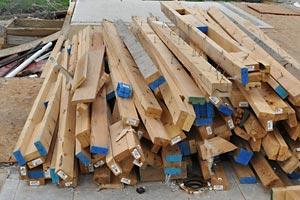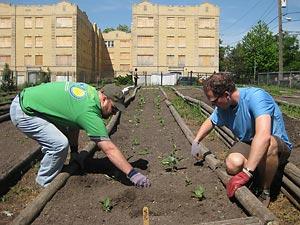Reuse and Recycling Opportunities and Demolition
Disposal Alternatives: Deconstruction, Reuse and Recycling
You should consider deconstruction, reuse and recycling during the pre-demolition planning. Careful identification of any harmful materials present will help ensure safe reuse and recycling. Deconstruction and recycling firms must be in compliance with state and federal requirements, including any licensing or registration regulations.
Deconstruction and Reuse

Some residential buildings may be good candidates for full deconstruction (rather than demolition) or pre-demolition salvage of materials with architectural value or reuse potential. Deconstruction provides opportunities for job training. It also prevents usable materials from going to the landfill, and makes used building materials available to the community.
- appliances
- bathtubs
- bricks
- dimensional lumber
- doors
- kitchen cabinets
- light fixtures
- marble
- sinks
- stones
- toilets
- windows
- wood flooring
To facilitate deconstruction, appropriate structures should be quickly identified and deconstructed to prevent arson, vandalism, or other damage to the building.
- Deconstruction Rapid Assessment Tool to help you quickly triage building stock slated for demolition
- Fact Sheets on Designing for the Disassembly and Deconstruction of Buildings
- Deconstructing Buildings
One way for a community to create incentives for deconstruction is to offer an expedited deconstruction permit.
City of Seattle's Residential Deconstruction Permit program Exit
- Delta Institute's Deconstruction and Reuse GO-Guide Exit
- Connecticut Dept. of Energy and Environmental Protection on Deconstruction Exit
- Abandoned Mobile Home Toolkit
Recycling
Local recycling markets may exist for non-hazardous demolition materials and land-clearing debris. For example, wood, metals, concrete, asphalt, brick and block are highly recoverable in many locations. Some non-hazardous materials can be reused on-site, in accordance with state and local requirements.
A demolition recycling specification that includes a goal or target for recycling sets an expectation that materials should be diverted from disposal.
- Organizations working to reduce the disposal of construction and demolition (C&D) materials
- Construction and Demolition Recycling Association (CDRA) Exit
- Construction Materials Recycling Association (CMRA) Master Specifications Exit- A generic solid waste management and recycling specification for demolition that can be modified to meet the needs of a specific project (from California Department of Resources Recycling and Recovery)
Site Reuse and Sustainable Communities

How will the site be used after the demolition? Your demolition plans or specifications may include measures that reflect the expected future use of the site.
For example, in some cases vacant parcels in urban areas will be used for green infrastructure or community gardens after the buildings are removed. If the demolition activity leaves concrete and other construction materials in the soil, it will be harder to use the site to grow crops or vegetation. It may be desirable to have the demolition plans/specifications call for removal of debris, leaving clean soil on the site to facilitate its reuse.
This is one example of how the way in which demolition or deconstruction is done will affect reuse of the site. The sustainable communities program has among its objectives the green reuse of vacant parcels in urban and suburban areas. More information about our sustainable communities programs:
